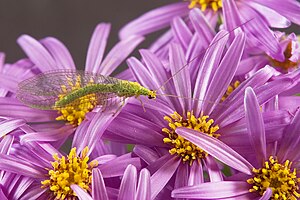Portal:Insects
The Insects Portal


Insects (from Latin insectum) are hexapod invertebrates of the class Insecta. They are the largest group within the arthropod phylum. Insects have a chitinous exoskeleton, a three-part body (head, thorax and abdomen), three pairs of jointed legs, compound eyes, and a pair of antennae. Insects are the most diverse group of animals, with more than a million described species; they represent more than half of all animal species. (Full article...)
Selected article -

Polistes exclamans, the Guinea paper wasp, is a social wasp and is part of the family Vespidae of the order Hymenoptera. It is found throughout the United States, Mexico, the Bahamas, Jamaica and parts of Canada. Due to solitary nest founding by queens, P. exclamans has extended its range in the past few decades and now covers the eastern half of the United States, as well as part of the north. This expansion is typically attributed to changing global climate and temperatures. P. exclamans has three specific castes, including males, workers, and queens, but the dominance hierarchy is further distinguished by age. The older the wasp is, the higher it is in ranking within the colony. In most P. exclamans nests, there is one queen who lays all the eggs in the colony. The physiological similarities between the worker and queen castes have led to experiments attempting to distinguish the characteristics of these two castes and how they are determined, though males have easily identifiable physiological characteristics. Since P. exclamans live in relatively small, open combed nests, they are often subject to predators and parasites, such as Chalcoela iphitalis, Elasmus polistis, and birds. P. exclamans have defense and recognition strategies that help protect against these predators and parasites. (Full article...)
Did you know -
- ... that along with Ithonidae, Polystoechotidae are regarded as the most primitive living members of the insect order Neuroptera?
- ... that the white-throated round-eared bat creates roosts inside the nests of the termite, Nasutitermes corniger?
- ... that Leptofoenus pittfieldae is the only species of Leptofoenus documented from the West Indies and the only member of Leptofoenus in the fossil record?
- ... that fluffy bums suck on passion vine juice?
- ... that Diorhabda carinata, D. sublineata and D. elongata, three species of leaf beetle in Eurasia and North Africa, are used as biological pest control agents against invasive tamarisk trees in North America?
List articles
Related portals
General images -
Selected image -

Green lacewings (Neuroptera: Chrysopidae) is a family of lacewings containing about 85 genera and (according to different sources) 1,300–2,000 species. Members of the genera Chrysopa (pictured) and Chrysoperla are very common in North America and Europe; they are very similar and many of their species have been moved from one genus to the other times and again.
WikiProjects

Main WikiProject:
Related projects:
- WikiProject Arthropods
- WikiProject Spiders
- WikiProject Animals
- WikiProject Tree of Life
- WikiProject Biology
Daughter projects:
Tasks
 |
Here are some tasks awaiting attention:
|
Associated Wikimedia
The following Wikimedia Foundation sister projects provide more on this subject:
-
Commons
Free media repository -
Wikibooks
Free textbooks and manuals -
Wikidata
Free knowledge base -
Wikinews
Free-content news -
Wikiquote
Collection of quotations -
Wikisource
Free-content library -
Wikiversity
Free learning tools -
Wiktionary
Dictionary and thesaurus



















































